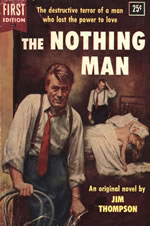The Nothing Man
 Cover Artist: Stanley Borack
Cover Artist: Stanley BorackBy: Thompson, Jim
Publisher: Dell Publishing Co., Inc. (Dell First Edition 22)
Place of Publication:New York, NY
Catalog #: Kelley Box 381: PS3539 .H6733 N675 1954
Contributor: J. Lukin
General
Era: 1940sAuthor as on Cover: Jim Thompson
Publication:1954
Original Date: 1954
Setting: urban; a newspaper office, a variety of shabby rural and borderline suburban homes
Plot Summary
Journalist Clinton Brown is an angry and fearful man: he is terrified that someone will discover and publicize the fact that he lost his penis in the war, and he imagines that the resulting shame and suspicion will be more than he can bear. So when his ex-wife begins to suspect the reason he divorced her, he can't trust her discretion -- he knocks her unconscious and sets her house on fire. When a voluptuous woman who's fallen in love with him discovers his injury, he throws her to a pack of starving dogs. And when a venal, spinsterish publisher hints that she's found clues to his guilt, he arranges for her to disappear. At least, that's his version of events. The local sheriff has other ideas and is determined to pursue them. But Clint wants to luxuriate in his guilt and prevent anyone else's taking the fall for crimes he knows he's committed. Unless it's his boss at the newspaper, the man who sent him into that minefield during the war and has felt burdened by a sense of responsibility for him ever since. Is Clint guilty of murder? Or would the worst punishment he could face be proof that he's innocent of what he claims to have done?Major Characters
Lem Stukey adult male, pretty-boy looks, slicked-down black hair, spreading midriff, friendly, corrupt small town police chiefClinton Brown "Brownie," adult male, six feet tall, handsome, journalist/copy editor/war veteran/poet
Tom Judge adult male, short, heavy-set, belligerent, impoverished and incompetent copy editor
Constance Wakefield adult female, middle-aged, rail-thin, oyster-eyed, proprietress of a vanity publishing house
Kay Randall adult female, gushily sentimental and dictatorial housewife who knows a thousand ways to cook with mayonnaise
Dave Randall "The Colonel," "Father," adult male, newspaper editor living a beleaguered life in the suburbs
Ellen Brown adult female, thick black hair, droopy behind, impulsive, suspected of prostitution
Deborah Chasen adult female, green eyes, coarse yellow hair, lightweight but imposing figure, wealthy and passionate but socially inept widow